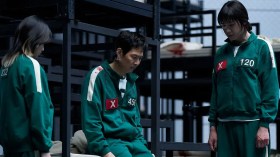What if it had been an Australian start-up that revolutionised the way we listen to music instead of Spotify? On one level, Marc Fennell’s latest two-part documentary for SBS – Red Flag: Music’s Failed Revolution – is basically just one long explanation as to why you’re right to think that never would have happened. But for a little while there, Gold Coast start-up company Guvera made it look like it could – and in the tech world, appearances can bring in a whole lot of money
But first, some backstory. Through the 90s, the music industry was raking in cash. CDs cost $30, artists were touring worldwide, and the big four record labels dominated an extremely profitable industry. Then online music piracy in the form of Napster tore it all down, sales dropped off a cliff and never recovered, and the industry desperately searched for a way to recoup at least some money online. Enter Guvera.
Red Flag: songs for free
Founder Claes (pronounced ‘Klaus’) Loberg came up with the idea in an airport. A Swedish-Australian entrepreneur with a shaggy rock-star look, his concept was simple: a platform where brands would pay for the music you’d otherwise pirate. You got the songs for free, they got to advertise to you, the artists still got paid.
The highly complex software required to make it work didn’t come out of thin air, and a lot of Red Flag is running through the local version of the now-traditional start-up story. Long hours, loads of commitment, last minute coding miracles and some (too) aggressive marketing; it’s all taking place on the Gold Coast, which isn’t exactly the natural home for tech companies.
Claes was a bit of a self-promoter, while Brad, the co-founder who was much more of a problem-solver (and the only one of the three-person board who appears on-camera), had a very different and much more down-to-earth approach to pretty much everything. No prizes for guessing who was squeezed out first.
Red Flag: colourful characters
It’s a solid story, with a bunch of colourful characters operating during a pivotal point in the development of the online world we currently … well, ‘enjoy’ doesn’t seem like quite the right term. Fennell’s been doing this kind of thing for a while now, and he and his team have put together a slick, engaging retelling of a tale that covers a surprisingly large stretch of ground.
ScreenHub: Stuff the British Stole: Marc Fennell on repatriation
There’s plenty of talking heads from the era (including musician Ben Lee), plus the occasional scene-setting re-enactment (footwear is surprisingly important when it comes to identifying who’s who). And if at times you might wonder if this story really needed two 75 ]-minute (with ads) episodes to be told, it’s hard to pin-point exactly what to cut. You can’t leave out a $400K launch party featuring Alice Cooper and Mos Def (who demanded to be paid in cash).

Touching on everything from the music scene to Guvera’s internal politics to Gold Coast strip clubs to the dot-com bubble to Australia’s historical disinterest in innovation – and Red Flag is only just getting started – a big part of the appeal of Red Flag is the way it explores a side of Australian culture that rarely gets a moment in the spotlight. Sportspeople, the beach and the bush are everywhere you look; a new tech crew doing things online isn’t exactly part of the Australian brand.
ScreenHub: Marc Fennell faces his Pentecostal past in The Kingdom
And then, of course, it all goes wrong. The money was always shaky, and exactly how advertisers were going to pay for your music was up in the air. Meanwhile, Claes was spending most of his time overseas, developing contacts in a way that looked very similar to partying with rock stars. ‘We were dealing with a product that was like a ship put to water that was only half built,’ says one former employee.
Red Flag: dodgy financing
By the end of the first episode, things are very different. The second instalment is less – a lot less – about the music, and more about a seemingly endless web of dodgy financing as the money men (now fully in control) look for ways to cash in and cash out of a business that’s fundamentally broken and bleeding money.
A lot of clueless small investors come onto the scene; things take a turn for the legitimately grim. A story that started out looking at the glory days of the local music industry ends up in a bleak financial hole where millions of dollars of other people’s money just vanished and nobody accepts blame. It’s not a feelgood story, that’s for sure.
Then again, this does feature the classic ‘you wouldn’t steal a car’ anti-piracy ad they used to put at the start of rental videotapes.
Red Flag: Music’s Failed Revolution is broadcast on 15 and 22 October 2024 at 8:35pm on SBS, with both episodes available to stream on SBS On Demand.
Actors:
Marc Fennell
Director:
Format: TV Series
Country: Australia
Release: 15 October 2024





